Related Research Articles
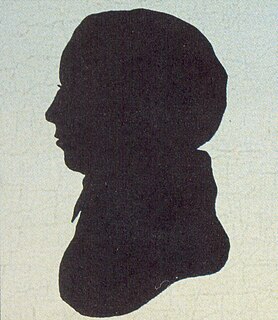
Francis Cabot Lowell was an American businessman for whom the city of Lowell, Massachusetts, is named. He was instrumental in bringing the Industrial Revolution to the United States.
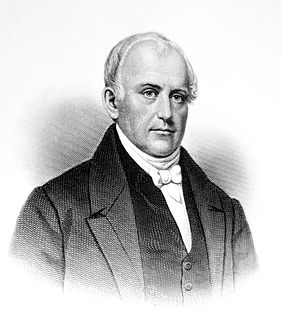
Samuel Slater was an early English-American industrialist known as the "Father of the American Industrial Revolution" and the "Father of the American Factory System". In the UK, he was called "Slater the Traitor" because he brought British textile technology to America, modifying it for United States use. He stole the designs of textile factory machinery as an apprentice to a pioneer in the British industry before migrating to the United States at the age of 21. He designed the first textile mills in the US and later went into business for himself, developing a family business with his sons. He eventually owned thirteen spinning mills and had developed tenant farms and company towns around his textile mills, such as Slatersville, Rhode Island.

Oliver Evans was an American inventor, engineer and businessman born in rural Delaware and later rooted commercially in Philadelphia. He was one of the first Americans building steam engines and an advocate of high pressure steam. A pioneer in the fields of automation, materials handling and steam power, Evans was one of the most prolific and influential inventors in the early years of the United States. He left behind a long series of accomplishments, most notably designing and building the first fully automated industrial process, the first high-pressure steam engine, and the first amphibious vehicle and American automobile.

The technological and industrial history of the United States describes the United States' emergence as one of the most technologically advanced nations in the world. The availability of land and literate labor, the absence of a landed aristocracy, the prestige of entrepreneurship, the diversity of climate and large easily accessed upscale and literate markets all contributed to America's rapid industrialization. The availability of capital, development by the free market of navigable rivers and coastal waterways, as well as the abundance of natural resources facilitated the cheap extraction of energy all contributed to America's rapid industrialization. Fast transport by the very large railroad built in the mid-19th century, and the Interstate Highway System built in the late 20th century, enlarged the markets and reduced shipping and production costs. The legal system facilitated business operations and guaranteed contracts. Cut off from Europe by the embargo and the British blockade in the War of 1812 (1807–15), entrepreneurs opened factories in the Northeast that set the stage for rapid industrialization modeled on British innovations.
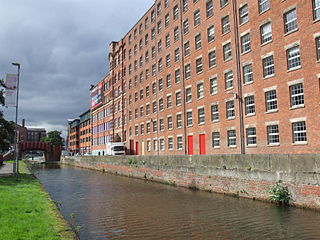
A cotton mill is a building housing spinning or weaving machinery for the production of yarn or cloth from cotton, an important product during the Industrial Revolution in the development of the factory system.
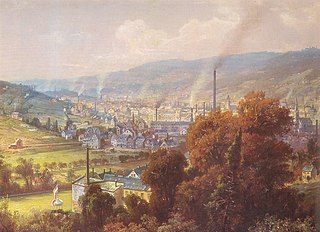
Textile manufacture during the Industrial Revolution in Britain was centred in south Lancashire and the towns on both sides of the Pennines. In Germany it was concentrated in the Wupper Valley, Ruhr Region and Upper Silesia, in Spain it was concentrated in Catalonia while in the United States it was in New England. The main key drivers of the Industrial Revolution were textile manufacturing, iron founding, steam power, oil drilling, the discovery of electricity and its many industrial applications, the telegraph and many others. Railroads, steam boats, the telegraph and other innovations massively increased worker productivity and raised standards of living by greatly reducing time spent during travel, transportation and communications.

The textile industry is primarily concerned with the design, production and distribution of yarn, cloth and clothing. The raw material may be natural, or synthetic using products of the chemical industry.
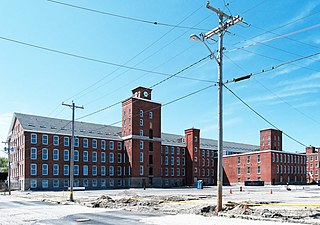
Wamsutta Mills was a textile manufacturing company located in New Bedford, Massachusetts, a port which was known as a center of the whaling industry. The company was named after Wamsutta, the son of a Native American chief who negotiated an early alliance with the English settlers of the Plymouth Colony in the 17th century. Wamsutta Company's textile mill was founded by Thomas Bennett, Jr. on the banks of the Acushnet River in 1846 and opened in 1848. It was the first of many textile mills that gradually came to overtake whaling as the principal employer in New Bedford. Other mills in the area soon sprang up. By the 1870s, cotton textile manufacture was more important to the local economy than whaling. Wamsutta Mills became well known for producing fine quality shirtings, sheetings and other fine cotton products. The Wamsutta brand continues to this day.

East Falls is a neighborhood in the Northwest section of Philadelphia, Pennsylvania, United States on the east or left bank side of the "Falls of the Schuylkill," cataracts submerged in 1822 by the Schuylkill Canal and Fairmount Water Works projects. East Falls sits next to the Germantown, Roxborough, Allegheny West, and Nicetown-Tioga neighborhoods, and to Wissahickon Valley Park. The neighborhood runs along a few miles of Ridge Avenue, along the banks of the Schuylkill River then extends northeast to Wissahickon Avenue. It overlooks the multi-use recreational path of Fairmount Park along Kelly Drive, and is desirable for its central location, an easy commute to Center City, with easy access to several major roadways and public transportation. East Falls continues to develop, with new housing, retail space and recreation centers in production. It has three streets with the word "Queen" in them, two train stations, a number of bars and restaurants, and illustrious mansions as well as some recently renovated housing.
Pendleton Woolen Mills is an American textile manufacturing company based in Portland, Oregon, United States. It is known for its blankets and woolen clothing.
Pope Manufacturing Company was founded by Albert Augustus Pope around 1876 in Boston, Massachusetts, and incorporated in Connecticut in 1877. Manufacturing of bicycles began in 1878 in Hartford, Connecticut, at the Weed Sewing Machine Company factory. Pope manufactured bicycles, motorcycles, and automobiles. From 1905 to 1913, Pope gradually consolidated manufacturing to the Westfield Mass plant. The main offices remained in Hartford. It ceased automobile production in 1915 and ceased motorcycle production in 1918. The company subsequently underwent a variety of changes in form, name and product lines through the intervening years. Yet all the way up to present-day, bicycles continue to be made available under the Columbia brand.
Courtaulds was a United Kingdom-based manufacturer of fabric, clothing, artificial fibres, and chemicals. It was established in 1794 and became the world's leading man-made fibre production company before being broken up in 1990 into Courtaulds plc and Courtaulds Textiles Ltd.

The Amoskeag Manufacturing Company was a textile manufacturer which founded Manchester, New Hampshire, United States. From modest beginnings in near wilderness, it grew throughout the 19th century into the largest cotton textile plant in the world.

The Lowell mill girls were young female workers who came to work in industrial corporations in Lowell, Massachusetts, during the Industrial Revolution in the United States. The workers initially recruited by the corporations were daughters of New England farmers, typically between the ages of 15 and 35. By 1840, at the height of the Textile Revolution, the Lowell textile mills had recruited over 8,000 workers, with women making up nearly three-quarters of the mill workforce.

William Weightman was a chemical manufacturer and one of the largest landowners in the United States. Nicknamed the "Quinine King," he invented a synthetic form of the drug. His company, Powers & Weightman, merged in the 1920s with the pharmaceutical giant Merck & Co.

The Lowell mills were 19th-century textile mills that operated in the city of Lowell, Massachusetts, which was named after Francis Cabot Lowell; he introduced a new manufacturing system called the "Lowell system", also known as the "Waltham-Lowell system".

The American Printing Company, located in Fall River, Massachusetts grew to become the largest producer of printed cotton cloth in the United States by the early 20th Century. The company grew as an offshoot of the Fall River Iron Works, established in 1821 by Colonel Richard Borden and Major Bradford Durfee. The American Print Works was established in 1835 by Holder Borden. It employed several thousand workers at its peak during World War I.

George Crompton was an American inventor, manufacturer, and businessman and the son of William Crompton, an inventor. He is best known for his invention, perfection, and popularization of the Crompton Loom, a fancy loom that could reach maximum speeds of eighty-five picks per second, nearly twice the speed of its most efficient predecessors. Crompton Loom Works, located in his hometown of Worcester, Massachusetts, aided in the Civil War effort to provide uniforms and blankets for the U.S. Army. Crompton's looms did have competition from foreign innovations, yet when brought to the Paris Exposition Universelle (1867) his products won a silver medal. His looms were also present at the Philadelphia Centennial Exposition of 1876. From these two events, the Crompton Loom gained popularity and became famous throughout the manufacturing circles. Crompton was also quite involved in his town of Worcester; he was a member of the common council (1860–1861) and held the office of alderman (1863–1864), in addition to running for mayor unsuccessfully in 1871. When he died, Worcester announced that it had lost the man who helped the town transform from a "pretty New England town" to an industrial city. Crompton was inducted into the National Inventors Hall of Fame in 2007 due to the large-scale impact of his loom.

Silk mill is a factory that makes silk for garments using a process called silk throwing. Traditionally, silk mills were concentrated in Japan, England, New Jersey, Pennsylvania and Switzerland.
Henry Roe Campbell was an American surveyor and civil engineer. Campbell contributed to American railroading and bridge-building in the first half of the 19th century. Campbell patented his 4-4-0 design in February 1836, just a few months before the patent law was changed to require that claims include proof of originality or novelty.
References
- 1 2 Miers, Busch. 1912. Official Pictorial and Souvenir Book of the Historical Pageant. pp. 155
- ↑ America's Textile Reporter: For the Combined Textile Industries. 1919.
| This article about an American businessperson born in the 1840s is a stub. You can help Wikipedia by expanding it. |